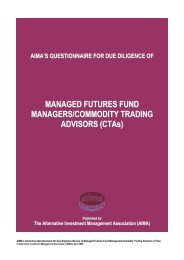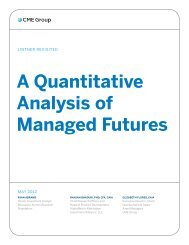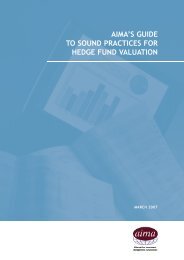Stochastic Volatility and Seasonality in ... - Interconti, Limited
Stochastic Volatility and Seasonality in ... - Interconti, Limited
Stochastic Volatility and Seasonality in ... - Interconti, Limited
Create successful ePaper yourself
Turn your PDF publications into a flip-book with our unique Google optimized e-Paper software.
The Futures data<br />
The CBOT soybean futures have seven expiration months <strong>in</strong> the sampl<strong>in</strong>g period: January,<br />
March, May, July, August, September, <strong>and</strong> November. At any particular date, more than<br />
seven soybean futures contracts may be traded s<strong>in</strong>ce for example futures with expiration <strong>in</strong><br />
July this year <strong>and</strong> next year may be traded simultaneously. The maximum number of futures<br />
contracts that are open at all the dates <strong>in</strong> our sample is eight. In order to have same number<br />
of futures observations at each sample date, we have thus chosen to only <strong>in</strong>clude the eight<br />
futures contracts with the shortest time to expiration at any sample date.<br />
In the estimation approach we need the times to maturity for the different futures contracts<br />
at the different sample dates. The contractual terms at CBOT specify that physical delivery<br />
(<strong>in</strong> the form of an <strong>in</strong>ventory receipt) may occur at any bus<strong>in</strong>ess day throughout the expiration<br />
month <strong>and</strong>, hence, that the last delivery day is the last bus<strong>in</strong>ess day of the month. However,<br />
the last trad<strong>in</strong>g day of the futures contract is the seventh bus<strong>in</strong>ess day preced<strong>in</strong>g the last<br />
bus<strong>in</strong>ess day of the delivery month. S<strong>in</strong>ce the last trad<strong>in</strong>g day is the last day that a contract<br />
can <strong>in</strong> pr<strong>in</strong>ciple be closed at CBOT without physical delivery, we have chosen this day as the<br />
expiration date when construct<strong>in</strong>g the times to maturity for the <strong>in</strong>volved futures contracts <strong>in</strong><br />
the estimations presented <strong>in</strong> the next section.<br />
Table 1 provides summary statistics with respect to the <strong>in</strong>volved soybean futures contracts.<br />
[ INSERT TABLE 1 ABOUT HERE ]<br />
The table states the average number of days to maturity <strong>and</strong> mean <strong>and</strong> st<strong>and</strong>ard deviation<br />
of all the soybean futures prices <strong>in</strong> the dataset. In addition, the tables provide summary<br />
statistics for the futures contracts categorized <strong>in</strong>to expirations months as well as the time to<br />
maturity of the contracts. In the follow<strong>in</strong>g, the term<strong>in</strong>ology “1. Maturity” is used as notation<br />
for the futures contract that has the shortest time to maturity at a given sample date; the “2.<br />
Maturity” represents the futures contract with the second shortest time to maturity, <strong>and</strong> so<br />
on.<br />
The table suggests at least three features of the soybean futures prices that are captured by<br />
the model <strong>in</strong> section 2. (i) Futures prices display a seasonal pattern s<strong>in</strong>ce the soybean futures<br />
price is on average high <strong>in</strong> July prior to the US harvest<strong>in</strong>g <strong>and</strong> low <strong>in</strong> November after the US<br />
harvest<strong>in</strong>g. (ii) The variability of futures prices also seem to have a seasonal pattern s<strong>in</strong>ce the<br />
st<strong>and</strong>ard deviations for the futures prices, when grouped <strong>in</strong>to expiration months, display the<br />
same time pattern as for the level of futures prices. And, (iii) the variability of long futures<br />
14


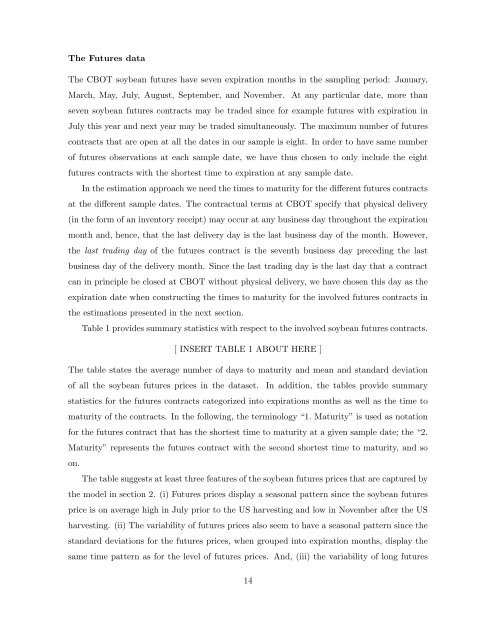

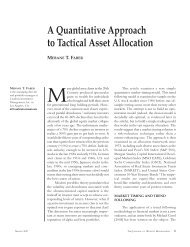


![Definitions & Concepts... [PDF] - Cycles Research Institute](https://img.yumpu.com/26387731/1/190x245/definitions-concepts-pdf-cycles-research-institute.jpg?quality=85)
